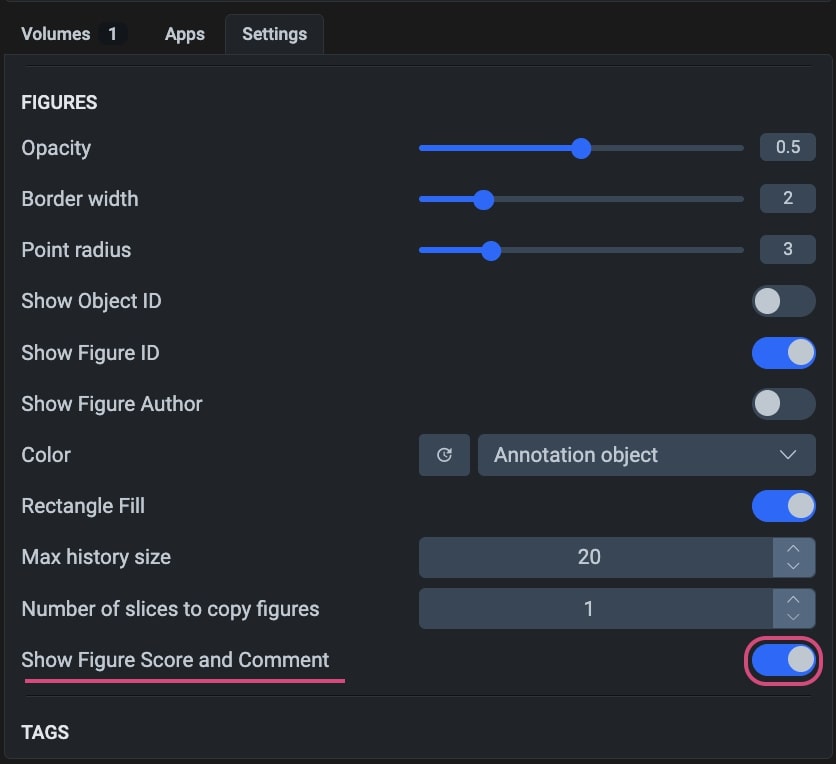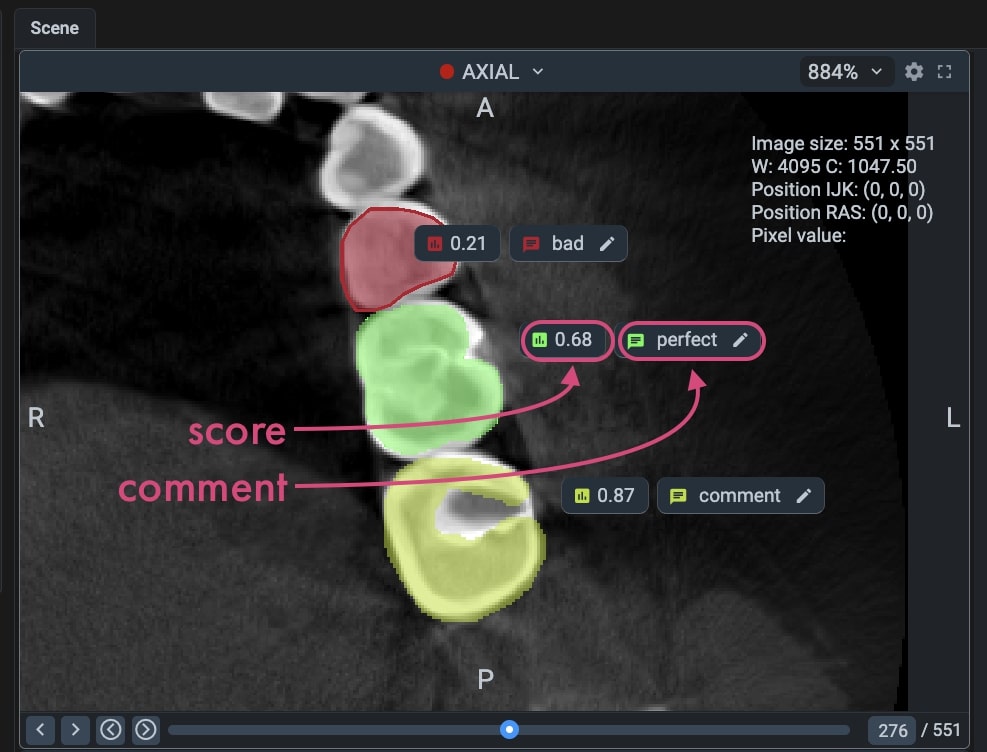Supervisely
Overview
Easily import your volumes with annotations in the Supervisely format. The Supervisely json-based annotation format supports such figures: rectangle, line (polyline), polygon, point, bitmap (mask), graph (keypoints). It is a universal format that supports various types of annotations and is used in the Supervisely platform.
Format description
Supported volume formats: .nrrd, .dcm
With annotations: yes
Supported annotation format: .json.
Data structure: Information is provided below.
Input files structure
Example data: download ⬇️.
Both directory and archive are supported.
Recommended directory structure:
Root 📁 project_name folder named with the project name
📄
meta.jsonfile📄
key_id_map.jsonfile (optional)📁
dataset_namefolders, each named with the dataset name and containing:📁
volumefolder, contains source volume files in NRRD file-format, for exampleCTChest.nrrd📁
ann- folder, with annotations for volumes. (named as volume +.json) for exampleCTChest.nrrd.json📁
maskoptional folder, created automatically while downloading project.📁 folders, named according to volume (
CTChest.nrrd), which contains an additional data files with geometries for annotation objects of class typeMask3Dstored in NRRD file format, named with hex hash code of objects from key_id_map. For example:daff638a423a4bcfa34eb12e42243a87.nrrd
📁
interpolationℹ️ optional folder, created automatically while downloading project.📁 folders, named according to volume (
CTChest.nrrd), which contains an additional data files in STL file format>), named with hex hash code of objects from key_id_map. For example:24a56a26ed784e648d3dd6c5186b46ca.stl
ℹ️ - It is recommended to upload 3D objects as Mask3D and not to use STL. But if you already have a prepared STL file, all STL interpolations will be automatically converter to a Mask3D object during project upload.
Format of Annotations
Example:
annotation JSON file - /project_name/dataset_name/ann/CTChest.nrrd.json
Annotation JSON fields definitions:
volumeMeta- metadata for 3D reconstruction of volumekey- string - a unique identifier of given object represented asUUID.hexvalue (used inkey_id_map.jsonto get the object ID)tags- list of strings that will be interpreted as volume tagsobjects- list of objects that may be present on the volumeplanes- a list of figures that defined in these planes:coronal, sagittal, axialspatialFigures- list of 3D figures may be present as the volume annotation
volumeMeta fields description:
ACS- string - "RAS" or "LPS" - name of type of Anatomical coordinate system i.e. RAS means is Right-Anterior-Superior
intensity-{"min": int, "max": int}- intensity range. Depends on the device getting the datawindowWidth- float - Specify a linear conversion. Window Width contains the width of the windowwindowCenter- float - Specify a linear conversion. Window Center contains the value that is the center of the windowchannelsCount- float - channel count of your image data. Default: 1dimensionsIJK- dict {"x": int, "y": int, "z": int} - dimensions of volume described as vector in IJK notationIJK2WorldMatrix- matrix to transform coordinates from IJK to world (cartesian). See here
Grayscale transformations to be applied to Pixel Data are defined by the equivalent of the Modality LUT and Rescale Intercept, Value of Interest Attributes, Photometric Interpretation and the equivalent of the Presentation LUT.
units = m*SV + b
rescaleSlope- float - m in the equation specified by Rescale InterceptrescaleIntercept- float - The value "b" in the relationship between stored values (SV) in Pixel Data and the output units specified in Rescale Type.
objects fields description:
key- string - a unique identifier of given object represented asUUID.hexvalue (used inkey_id_map.jsonto get the object ID)classTitle- string - the title of a class. It's used to identify the class shape from themeta.jsonfiletags- list of strings that will be interpreted as object tagslabelerLogin- string - the name of the user that added this figure to the projectupdatedAt- string - the date and time when theobjectwas updated (ISO 8601 format)createdAt- string - the date and time when theobjectwas updated (ISO 8601 format)
planes fields description:
name- string - the name of the plane, where the figures are placed. Can be coronal, sagittal or axial
Anatomical space
normal - dict with x, y, z as keys and 0/1 as values - normal is direction by axis, chosen according to plane name
slices- list of slices on the plane. Each list contains index and may contain figures.
slices fields description:
index- int value of slice index
spatialFigures fields description
This list contains 3D objects of type Mask3D
key- string - unique key for a given figure (used inkey_id_map.json)objectKey- string - unique key to link figure to object (used inkey_id_map.json)geometryType-mask_3dor other 3D geometry-class shapegeometry- geometry of the object
customData fields description
This field is used to store additional metadata for the figure, such as scores and comments. It is a dictionary with keys representing the plane and slice index, and values containing the metadata.
CustomData is a optional dictionary with the following structure:
0-0-1- plane identifier (0-0-1for axial,0-1-0for coronal,1-0-0for sagittal)51- slice indexscore- score value for the figure (optional)comment- comment text for the figure (optional)
For Mask3D objects, the customData field can contain metadata for multiple planes and slices. The keys are structured as follows:
To view the scores and comments in the Labeling Toolbox, you need to enable the "Show Figure Score and Comment" option in the toolbox settings.

After enabling this option and uploading the volumes and annotations with scores, you will see the scores and comments in the Labeling Toolbox.

NRRD files in mask folder
mask folderThese files contain geometry for 3D annotation objects, every file name must be the same as figure key to which it belongs.
Example:
/project_name/dataset_name/mask/CTChest.nrrd/daff638a423a4bcfa34eb12e42243a87.nrrd connected with spatial figure "key": "daff638a423a4bcfa34eb12e42243a87"
Definitions for its fields can be found here
Key id map file
/project_name/key_id_map.json file is optional. It is created when annotating the volume inside Supervisely interface and sets the correspondence between the unique identifiers of the object and the volume on which the figure is located. If you annotate manually, you do not need to create this file. This will not affect the work being done.
JSON file format of key_id_map.json:
objects- dictionary, where the key is a unique string, generated inside Supervisely environment to set mapping of current object in annotation, and value is unique integer ID related to the current objectfigures- dictionary, where the key is a unique string, generated inside Supervisely environment to set mapping of object on volume in annotation, and value is unique integer ID related to the current volumevideos- dictionary, where the key is unique string, generated inside Supervisely environment to set mapping of volumes in annotation, and value is a unique integer ID related to the current volumetags- dictionary, where the keys are unique strings, generated inside Supervisely environment to set mapping of tag on current volume in annotation, and value is a unique integer ID related to the current tagKey - generated by python3 function
uuid.uuid4().hex. The unique string. All key and ID values should be unique inside single project and can not be shared between entities.Value - returned by server integer identifier while uploading object / figure / volume / tag.
Useful links
Last updated